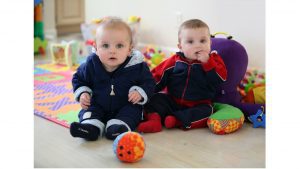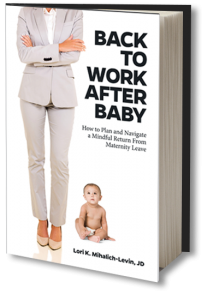 Daycare. The pre-mom version of myself harbored certain stereotypes about the concept of a daycare center. Preconceived notions informed by no real-life experience, mind you. “How does it actually work, with all those kids?” I wondered. “Your baby really is okay?” I asked other parents with thinly-veiled skepticism.
Daycare. The pre-mom version of myself harbored certain stereotypes about the concept of a daycare center. Preconceived notions informed by no real-life experience, mind you. “How does it actually work, with all those kids?” I wondered. “Your baby really is okay?” I asked other parents with thinly-veiled skepticism.
The truth was: I’d never really seen one. Never been in one. Never even knew someone who had gone to one. Growing up in the suburbs in the ‘80’s with a mom who stayed home while I was little, I didn’t have any friends who had gone to daycare. Sure, I attended preschool around age 3. But any experience with “leaving a baby in the hands of strangers unable to be cared for one-on-one”? Never.
And yet. When my turn at motherhood came around, my husband and I somehow unanimously landed on daycare as our preferred choice. Why? It seemed like the best of the options we had.
Neither my husband nor I was up for pausing our careers to stay home longer than the length of our respective parental leaves. Nannies were prohibitively expensive, and having family watch our baby wasn’t an option. We weren’t interested in having someone else live with us, so the au pair idea was out. And even if a nanny share or an in-home daycare would have been more affordable, we wanted a setting with more oversight. More regulations. Other adults around to keep an eye out. And a community of little ones for our children to get to know.
So perhaps in part, we defaulted to a preference for a daycare center. They’re not all the same, of course. And we did our diligence, scouting out all the local options. We asked friends and colleagues for the names of all the local centers and then scheduled tours. One per month of my pregnancy, so we had made the rounds by the time our baby arrived. I learned the most important things to look for in a good center, namely longevity of staff and great caregiver-to-child ratios. And when we found our top choice, we knew in a heartbeat that it was the place we wanted to send our baby.
Then the lobbying began. Yes, I said lobbying. (I do live in D.C. after all, folks.) And with the price of real estate around here, there’s a shortage of daycare centers. Waitlists are twelve miles long. Slots don’t always come open when you need them. And we were determined.
My husband volunteered to start the phone call campaign, on some advice we’d heard that more moms call than dads, so he would stand out to the center directors. (Plus, if you know my husband, you know he can befriend, disarm, and make an impression on absolutely anyone.) When our son was born, we wrote a letter to our top-choice center, letting them know about our latest arrival. And we asked them: “wouldn’t you like to increase the diversity of your center by caring for a delightful redhead?”
Our strategy worked, and a slot came open for us the month before I needed it. Yes, it meant paying for an additional month of childcare that we would have preferred not to have paid. But we were happy to make the investment in our peace of mind, and we used that time to transition our baby gradually.
I’ll admit to my terror the first day I dropped off my son. “What am I doing??” I asked myself, knowing I had done my homework on the amazing center, but forgetting that trust grows over time. I went home that morning. Cried. Pumped. Put myself back together, and then walked back to the center to pick him up. He was completely fine. Of course.
As we made that transition to childcare, I had so many fears and worries. My son only ever napped on me…how would he ever nap in a crib in a room with other babies? The answer? They used a swing a bit to help at the beginning. Then they would pat his back as he learned to fall asleep in the crib. Baby peer pressure helped (yes, it’s a real thing!), and within a few weeks, he was sleeping better at daycare than he ever had at home.
I was also worried that he’d starve. Because of a lipase issue with my breastmilk that caused it to turn sour after a few hours if I didn’t scald it, my son had a rough start with the bottle and was completely opposed to the idea of drinking from one. What if the center staff couldn’t get him to eat? The answer? They held him and sang to him while he ate, and they were the most patient people on the face of this earth while he learned to love his bottle. And yes, I said love. Though unimaginable for me in those early days, he was sad to see his bottle go, when it came time for the sippy cup. (Muchkin proved to be our favorite.)
My youngest son graduated from daycare last summer. And once again, I cried. Though this time, they were tears of joy, mixed with the sadness of leaving a daycare community that had truly become an extended family for us. Even now, the daycare teachers continue to babysit for our family. And my sons are still friends with the kids they met there.
Yes, we dealt with the headaches of contagious illnesses, having to get everyone out the door in the morning, and weeks when the daycare was closed for staff training and the like. But if I had to do it over again, I’d make the same choice. For us, daycare proved to be the perfect setting for our boys to learn to thrive in the world. And we remain deeply grateful to the amazing caregivers who continue to love our boys to this day.
For more Mindful Return posts on childcare-related issues, see:
- In-Home Daycares: The Scoop from 5 Moms Who Have Used Them
- Exploring the Au Pair Option for Child Care
- When a Family Member is Your Child Care Provider
- 5 Tips for Finding the Perfect Nanny or Babysitter
- How to Have a Successful Nanny Relationship from the Start
- Transitioning Your Baby to Childcare
- What is Back-Up Childcare and How Does It Work? An Interview with 3 Working Mamas
- Trusting Your Child Care Provider: Two Pieces to the Trust Puzzle
- Sending Milk and Food to Daycare: Logistical Tips and Tricks
 If you need more help getting your head in a better place to return to work after maternity leave, join us for the next session of Mindful Return.
If you need more help getting your head in a better place to return to work after maternity leave, join us for the next session of Mindful Return.
Want more practical tips on working parenthood? Check out my book, Back to Work After Baby: How to Plan and Navigate a Mindful Return from Maternity Leave.


